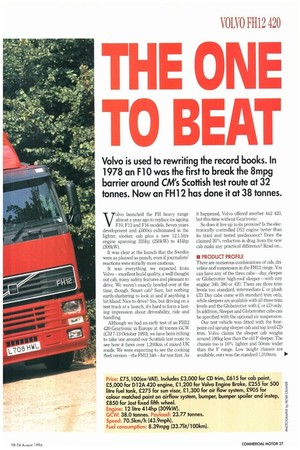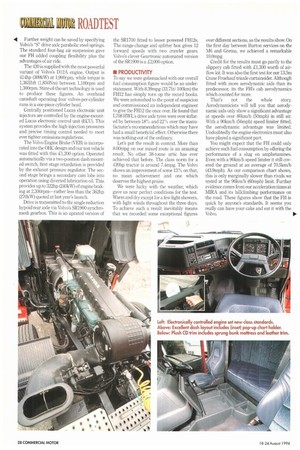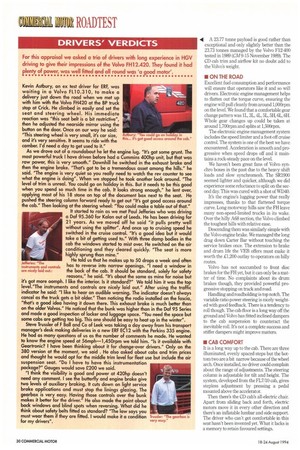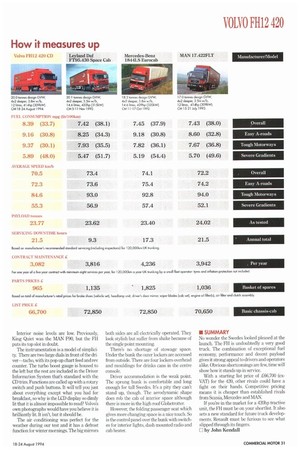Volvo is used to rewriting the record books. In 1978
Page 29

Page 30

Page 32

Page 33

If you've noticed an error in this article please click here to report it so we can fix it.
an F10 was the first to break the 8mpg barrier around CM's Scottish test route at 32 tonnes. Now an FH12 has done it at 38 tonnes.
Volvo launched the FH heavy range almost a year ago to replace its ageing F10, F12 and F16 models. Seven years development and £600m culminated in the lighter, sleeker, cab plus a new 12.1-litre engine spanning 335hp (250kW) to 414hp (309kW).
It was clear at the launch that the Swedes were as pleased as punch, even if journalists' reactions were initially more cautious.
It was everything we expected from Volvo—excellent build quality; a well thought out cab, many safety features and pleasant to drive. We weren't exactly bowled over at the time, though. Smart cab? Sure, but nothing earth-shattering to look at and if anything a bit bland. Nice to drive? Yes, but driving on a test track at a launch, it's hard to form a lasting impression about driveability, ride and handling.
Although we had an early test of an FH12 420 Geartronic in Europe at 40 tonnes GCW (CM 7-13 October 1993), we have been itching to take one around our Scottish test route to see how it fares over 1,200km of mixed UK roads. We were expecting to see the cooking fleet version—the FH12 340—for test first. As
it happened, Volvo offered another 4x2 420, but this time without Geartronic.
So does it live up to its promise? Is the electronically controlled D12 engine better than its tried and tested predecessor? Does the claimed 20% reduction in drag from the new cab make any practical difference? Read on...
• PRODUCT PROFILE
There are numerous combinations of cab, driveline and suspension in the FH12 range. You can have any of the three cabs—day, sleeper or Globetrotter high-roof sleeper—with any engine: 340, 380 or 420. There are three trim levels too: standard, intermediate C or plush CD. Day cabs come with standard trim only, while sleepers are available with all three trim levels and the Globetrotter with C or CD only. In addition, Sleeper and Globetrotter cabs can be specified with the optional air suspension.
Our test vehicle was fitted with the fourpoint coil sprung sleeper cab and top level CD trim. Volvo claims the sleeper cab weighs around 100kg less than the old F sleeper. The chassis too is 10% lighter and 50mm wider than the F range. Low height chassis are available, ours was the standard 1,010mm. lo • Further weight can be saved by specifying Volvo's "S" drive axle parabolic steel springs. The standard four-bag air suspension gave our FH added coupling flexibility plus the advantages of air ride.
The 420 is supplied with the most powerful variant of Volvo's D12A engine. Output is 414hp (309kW) at 1,900rpm, while torque is 1,3631bft (1,850Nm) between 1,100rpm and 1,300rpm. State-of-the-art technology is used to produce these figures. An overhead camshaft operating four valves-per-cylinder runs in a one-piece cylinder head.
Centrally positioned Lucas electronic unit injectors are controlled by the engine-mounted Lucas electronic control unit (ECU). This system provides the high injection pressures and precise timing control needed to meet ever tighter emissions regulations.
The Volvo Engine Brake (VEB) is incorporated into the OHC design and our test vehicle was fitted with this £1200 option. Operated automatically via a two-position dash mounted switch, first stage retardation is provided by the exhaust pressure regulator. The second stage brings a secondary cam lobe into operation using diverted lubrication oil. This provides up to 322hp (240kV/) of engine braking at 2,300rpm—rather less than the 362hp (270kW) quoted at last year's launch.
Drive is transmitted to the single reduction hypoid rear axle via Volvo's SR1900 synchromesh gearbox. This is an uprated version of the SR1700 fitted to lesser powered 11112s. The range-change and splitter box gives 12 forward speeds with two crawler gears. Volvo's clever Geartronic automated version of the SR1900 is a £2,000 option.
• PRODUCTIVITY To say we were gobsmacked with our overall fuel consumption figure would be an understatement. With 8.39mpg (33.71it/ 100km) the FH12 has simply torn up the record books. We were astonished to the point of suspicion and commissioned an independent engineer to give the FH12 the once over. He found that L708 HWL's drive axle tyres were over-inflated by between 18% and 22% over the manufacturer's recommendations which may have had a small beneficial effect. Otherwise there was nothing out of the ordinary.
Let's put the result in context. More than 8.00mpg on our mixed route is an amazing result. No other 38-tonne artic has ever achieved that before. The class norm for a 420hp tractor is around 7.4mpg. The Volvo shows an improvement of some 13% on that, no mean achievement and one which deserves the highest praise.
We were lucky with the weather, which gave us near perfect conditions for the test. Warm and dry except for a few light showers, with light winds throughout the three days. To achieve such a result inevitably means that we recorded some exceptional figures over different sections, as the results show. On the first day between Burton services on the M6 and Gretna, we achieved a remarkable 10.0mpg.
Credit for the results must go partly to the slippery cab fitted with £1,300 worth of airflow kit. It was also the first test for our 13.5m Crane Fruehauf triaxle curtainsider. Although fitted with more aerodynamic aids than its predecessor, its the FH's cab aerodynamics which counted for more.
That's not the whole story. Aerodynamicists will tell you that aerodynamic aids only show a significant advantage at speeds over 80km/h (50mph) in still air. With a 90km/h (56mph) speed limiter fitted, the aerodynamic advantage was limited. Undoubtedly the engine electronics must also have played a significant part.
You might expect that the FH could only achieve such fuel consumption by offering the performance of a slug on amphetamines. Even with a 90km/h speed limiter it still covered the ground at an average of 70.5km/h (43.9mph). As our comparison chart shows, this is only marginally slower than rivals we tested at the 96ktn/h (60mph) limit. Further evidence comes from our acceleration times at MIRA and its hillclimbing performance on the road. These figures show that the FH is quick by anyone's standards. It seems you really can have your cake and eat it with the Volvo.
A 23.77 tonne payload is good rather than exceptional and only slightly better than the 23.73 tonnes managed by the Volvo F12-400 tested in 1989 (CM 9-15 November 1989). The CD cab trim and airflow kit no doubt add to the Volvo's weight.
• ON THE ROAD Excellent fuel consumption and performance will ensure that operators like it and so will drivers. Electronic engine management helps to flatten out the torque curve, ensuring the engine will pull cleanly from around 1,000rpm on the level. We found that a comfortable gear change pattern was 1L, 3L, 4L, 5L,51-1, 6L, 611. Whole gear changes up could be taken at around 1,700rpm and splits at 1,500rpm.
The electronic engine management system includes the speed limiter and a foot-off cruise control. The system is one of the best we have encountered. Acceleration is smooth and progressive when speed drops off and it maintains a rock-steady pace on the level.
We haven't been great fans of Volvo synchro boxes in the past due to the heavy shift loads and slow synchromesh. The SR1900 seemed lighter and quicker, although we did experience some reluctance to split on the second day. This was cured with a shot of WD40.
It's the engine's lugging power that really impresses, thanks to that flattened torque curve. Long motorway hills saw the FH leave many non-speed-limited trucks in its wake. Over the hilly A68 section, the Volvo climbed the toughest hills with relative ease.
Descending them was similarly simple with the Volvo engine brake. We managed the long drag down Carter Bar without touching the service brakes once. The extension to brake and drum life the VEB offers must make it worth the £1,200 outlay to operators on hilly routes.
Volvo has not succumbed to front disc brakes for the FH yet, but it can only be a matter of time. No complaints about its drum brakes though, they provided powerful progressive stopping on track and road.
Handling and roadholding is top notch. The variable ratio power steering is nicely weighted with good feedback. There is a tendency to roll though. The cab floor is a long way off the ground and Volvo has fitted inclined dampers to the cab suspension to counteract the inevitable roll. It's not a complete success and stiffer dampers might improve matters.
• CAB COMFORT It is a long way up to the cab. There are three illuminated, evenly spaced steps but the bottom two are a bit narrow because of the wheel arch. Once installed, no driver could complain about the range of adjustments. The steering column is adjustable for tilt and height. The system, developed from the FL7/10 cab, gives stepless adjustment by pressing a pedal mounted above the accelerator.
Then there's the CD cab's all-electric chair. Apart from sliding back and forth, electric motors move it in every other direction and there's an inflatable lumbar and side support. The driver who can't get comfortable in this seat hasn't been invented yet. What it lacks is a memory to retain favoured settings. Interior noise levels are low. Previously, King Quiet was the MAN F90, but the FH puts its top slot in doubt.
The instrumentation is a model of simplicity. There are two large dials in front of the driver-tacho, with its pop-up chart feed and rev counter. The turbo boost gauge is housed to the left but the rest are included in the Driver Information System that's standard with the CD trim. Functions are called up with a rotary switch and push buttons. It will tell you just about everything except what you had for breakfast, so why is the LCD display so dimly lit that it is almost impossible to read? Volvo's own photographs would have you believe it is brilliantly lit. It isn't, but it should be.
The air conditioning was perfect for the weather during our test and it has a defrost function for winter mornings. The big mirrors
both sides are all electrically operated. They look stylish but suffer from shake because of the single point mounting.
There's no shortage of stowage space. Under the bunk the outer lockers are accessed from outside. There are four lockers overhead and mouldings for drinks cans in the centre console.
Driver accommodation is the weak point. The sprung bunk is comfortable and long enough for tall Swedes. It's a pity they can't stand up, though. The aerodynamic shape does rob the cab of interior space although there is more in the high-roof Globetrotter.
However, the folding passenger seat which gives more changing space is a nice touch. So is the control panel over the bunk with switches for interior lights, dash-mounted radio and cab heater.
• SUMMARY
No wonder the Swedes looked pleased at the launch. The is undoubtedly a very good truck. The combination of exceptional fuel economy, performance and decent payload gives it strong appeal to drivers and operators alike. Obvious shortcomings are few, time will show how it stands up in service.
With a starting list price of £66,700 (exVAT) for the 420, other rivals could have a fight on their hands. Competitive pricing means it is cheaper than established rivals from Scania, Mercedes and MAN.
If you're in the market for a 420hp tractive unit, the FH must be on your shortlist. It also sets a new standard for future truck developments. Renault must be furious to see what slipped through its fingers.
0 by John Kendall
























































































